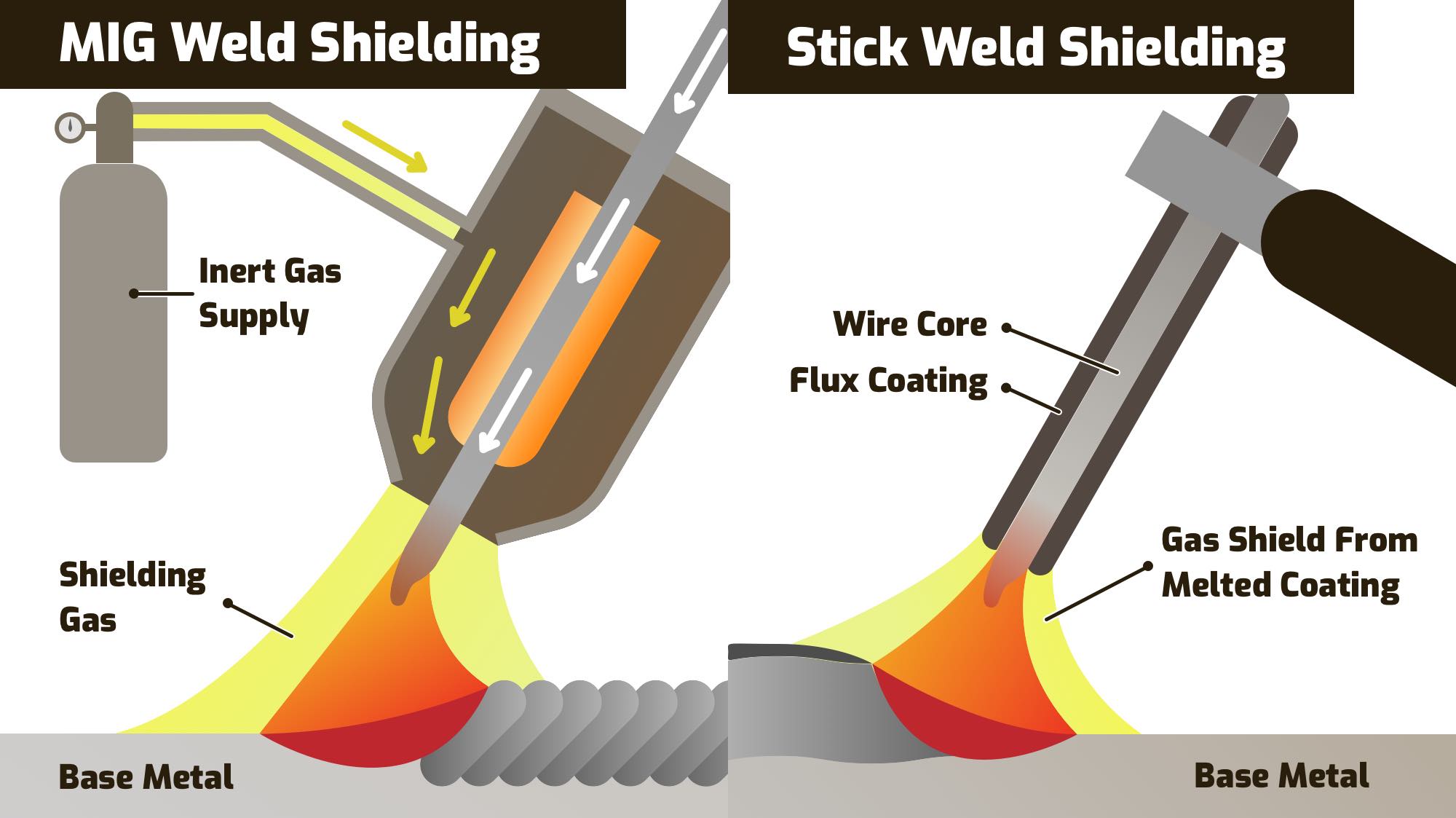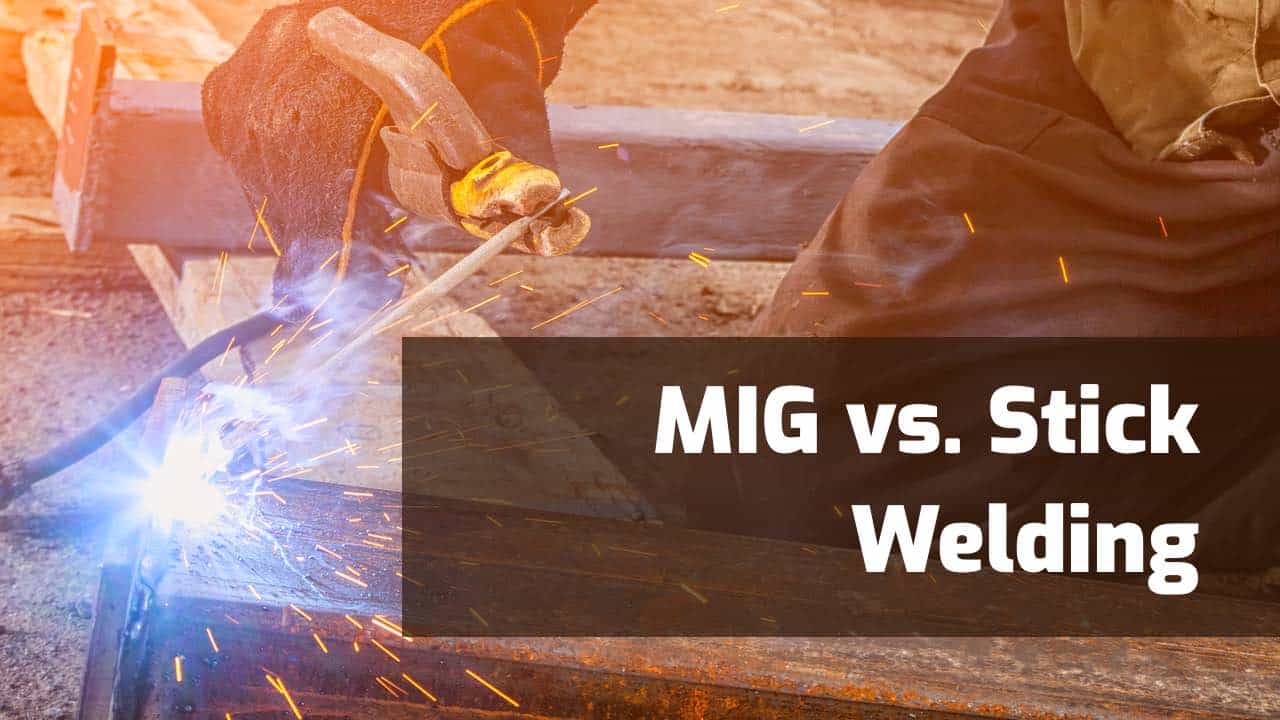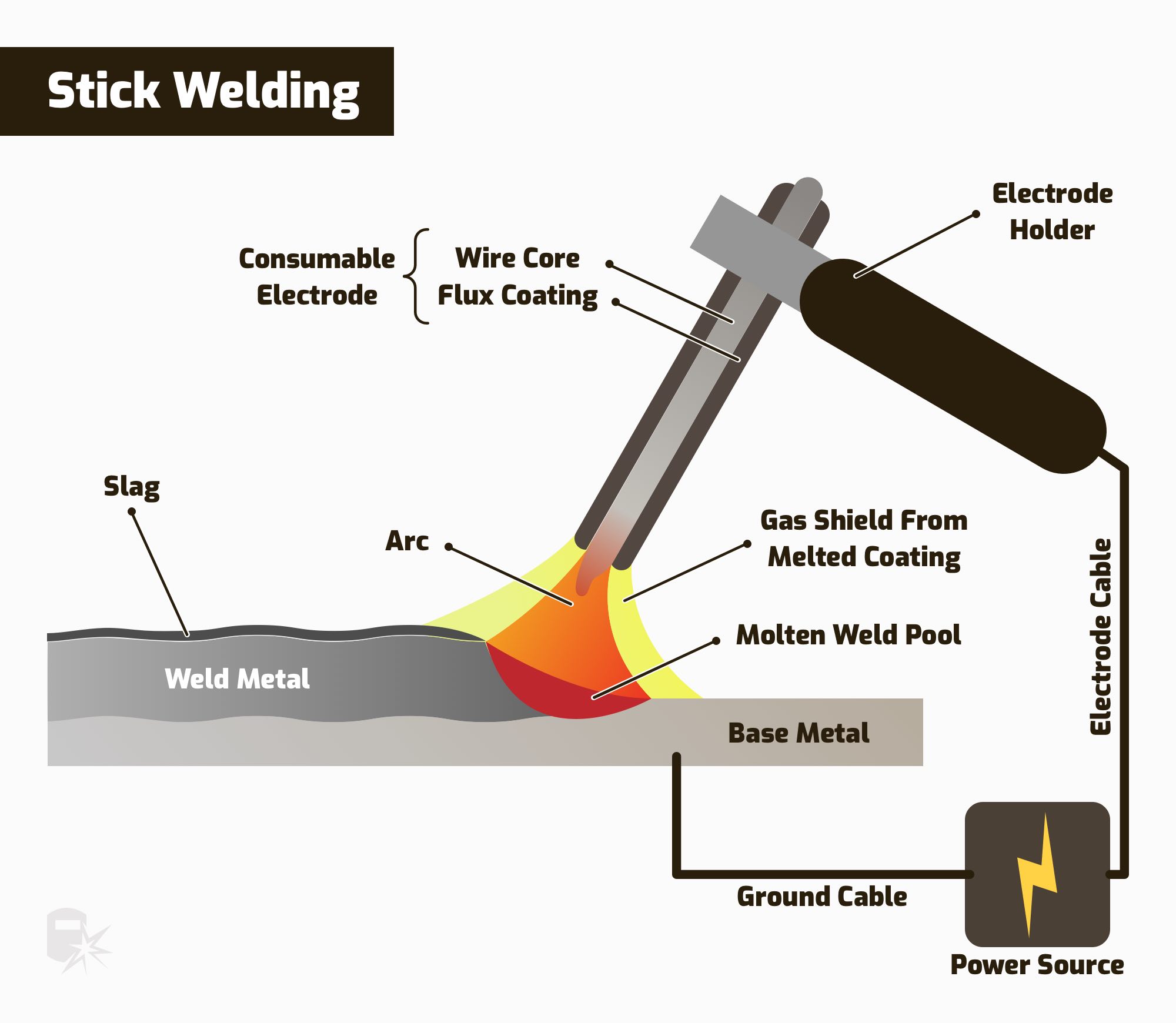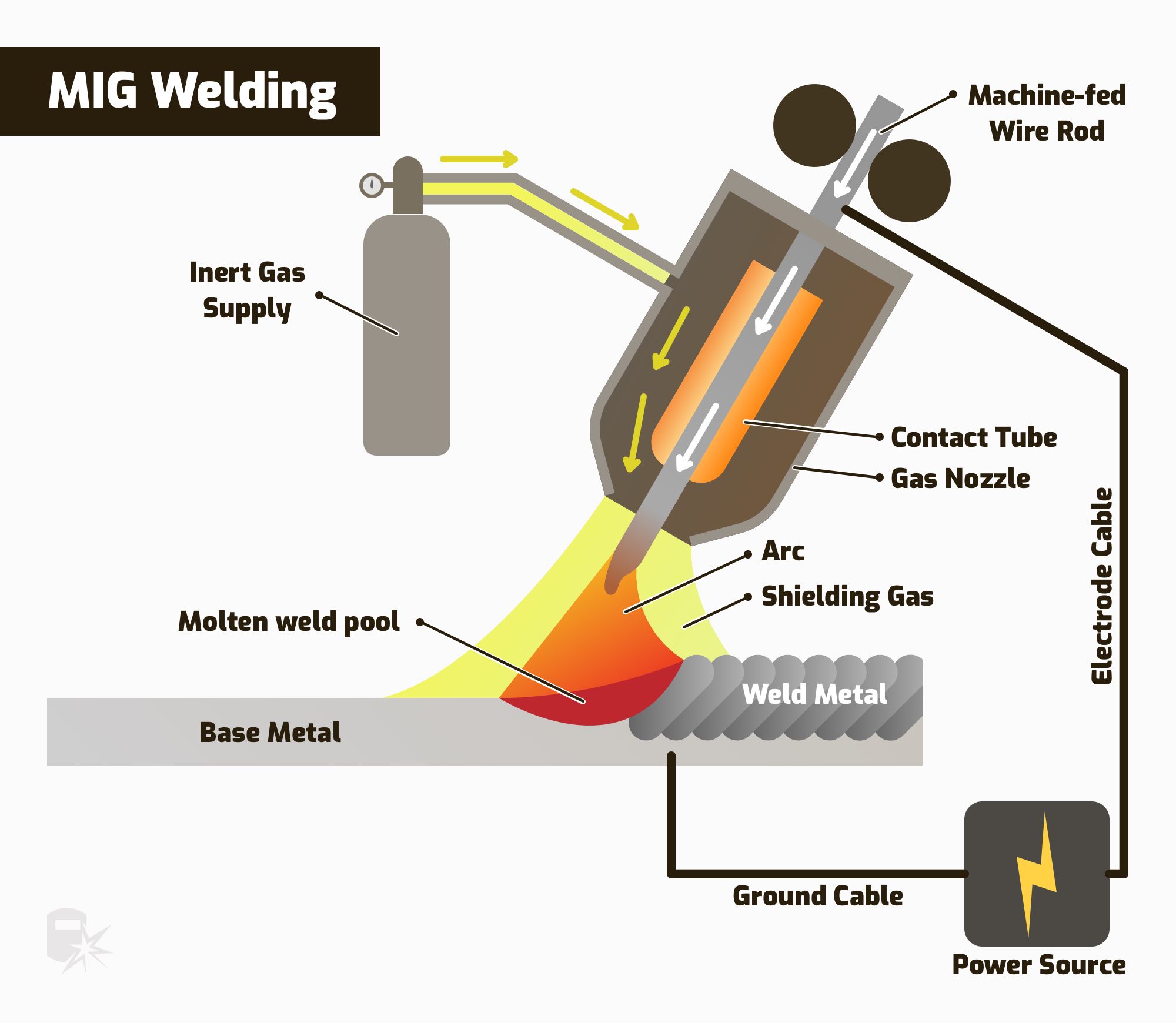Stick and MIG welding are two of the most commonly used processes, and they are both something beginners can learn.
The main difference between MIG and Stick welding is the electrode they use to create the arc and the shielding gas. MIG uses a consumable solid wire that is machine fed and a separate shielding gas, whereas Stick welding uses coated electrode that burns to create its own shielding gas.
This is a simple explanation and there are many more complex differences which will we explore below.
But before we do, here’s a quick overview of the differences summarized…
Quick Overview of MIG vs Stick
| MIG | Stick | |
|---|---|---|
| Arc start, ease of use | ✅ Pull trigger and weld | ⛔ Scratch start, electrode can stick |
| Setup/Learning curve | ⛔ Moderate | ✅ Low |
| Cost | ⛔ $$ | ✅ $ |
| Surface prep | ⛔ Bright white metal is best | ✅ Works through paint, rust, and dirt |
| Wind | ⛔ Less than 5 MPH | ✅ Up to 35 MPH |
| Post clean Up | ✅ Very Little | ⛔ Slag and Spatter Cleaning |
| Thin stock | ✅ Down to 24 ga. | ⛔ 1/8 or thicker |
| Thick stock | ⛔ Acceptable with enough power | ✅ Good penetration, over 3/8in. thick stick is the best choice |
| Cast iron | ⛔ Possible, but weaker weld | ✅ Better penetration, stronger than MIG |
| Aluminum | ✅ Cleaner than stick | ⛔ Possible but messier |
| Recommended machines | View MIG Welders | View Stick Welders |
If you’re unfamiliar with the other common processes (MIG, Flux-core & TIG), it will be worth your time to get an overview of these widely used welding processes.
Basics for Stick Welding
The formal name for stick welding is shielded metal arc welding (SMAW). It is also known as manual metal arc welding, flux shielded arc welding, or informally as stick welding. It is a manual arc welding process that uses a consumable electrode covered in flux.
The welding rod is usually about 14 inches long and is held in an electrode holder. The ground cable is then connected to the piece to complete the electrical circuit.
When the electrode is struck against the stock, an arc forms, and as you stick weld, the electrode is consumed. The flux coating provides a protective gas shield to the molten pool, keeping reactive gases in the air from contaminating your weld.
The ease of use and small learning curve allows beginners to start stick welding quickly. It is often considered the most basic and easiest form of welding.
Pros
- Easy to set up and learn
- Works in windy conditions
- Better penetration handles thick stock well
- Affordable
- Tolerates some paint, rust, and dirt
- Welds cast iron well
- Portable
Cons
- Produces slag and splatter that requires cleaning
- Scratch start, electrodes can stick
- Aluminum welds are possible but spatters more and rods are difficult to store
- Will not work on stock less than 1/8 in.
Basics for MIG Welding
Metal inert gas (“MIG”) welding is in the gas metal arc welding (“GMAW”) family of welding. When an active shielding gas is used, it is called metal active gas (“MAG”) welding. You can read more on MIG and MAG differences here.
A solid wire electrode is fed from a wire spool to a specialized “gun.” Shielding gas supplied from a tank of gas is also fed to the gun. An arc formed between the electrode wire and base metal allows you to MIG weld, and the wire is consumed as it is fed into the weld pool.
The setup is a little more complex compared to stick welding, but MIG welding is easy to learn and use, even though it is not as simple as stick welding.
Pros
- Simple to use, pull the trigger and weld
- No slag, less spatter, cleaner than stick
- Handles thin metal well
- Less time spent putting in wire spools vs. stick electrodes
- Produces far more feet of beads per hour
- Can produce clean, professional aluminum welds
- Has more settings, control over the arc
Cons
- A bit harder to set up for a weld
- More expensive than stick
- Needs clean, bright white prep
- Wind blows away shielding gas, even light breezes can be a problem
- Not the best choice for cast iron
- Gas tank makes less portable than stick
Similarities of MIG & Stick Welding
Stick and MIG welding are both arc welding processes. To protect the molten weld pool, each introduces a shielding gas to blanket and protect the weld puddle from atmospheric gases. Plus, both are capable of producing quality welds.
But the similarities continue. The two welding processes each use a welding consumable electrode that must be continually replenished. Also, both processes weld mild and stainless steel, as well as cast iron and aluminum.
So, at a basic level, they are more similar than some may think. But as you get deeper into the details, the differences start to emerge.
MIG & Stick Differences
Shielding

During welding, reactive gases in the air react with molten metal, like oxygen and carbon dioxide. This results in weld defects, and of course, you want to avoid these kinds of problems.
MIG welders solve the problem by pumping an inert gas, like argon, from a tank through the lead all the way to the MIG gun. The gas flows from your torch and settles over the hot metal. The blanket of inert gas lingers long enough to prevent defects caused by the reactive gases.
Introducing gas from a tank, MIG welders allow users to change out the shielding gas, and it is common to use a mixture of argon and carbon dioxide. Yes, the carbon dioxide is reactive, but in safe, small amounts, a blend makes your arc more stable and reduces spatter.
On the other hand, stick welders create gas using a special external layer of flux applied to the stick electrode. As you consume the electrode, the heat also activates the flux, which generates the shielding gas needed to protect the weld.
This gas is also partially contained by the slag that also forms from the flux. So, the shielding gas mechanism with a stick welder is quite different from the “pumped” gas found in a MIG unit.
Read more on what flux is used for here.
Indoor vs. Outdoor Use
Outdoors on a windy day, a MIG torch will have trouble keeping shielding gas on the weld pool. The gas is simply blown away as it flows from the torch and does not blanket the weld.
But with a stick welder, the shielding is outgassing from the flux reacting with the weld puddle. Also, the flux creates slag, a sort of shell that helps keep the inert gases in place. Generating the gas in this manner better covers the weld in windy conditions, up to 35 MPH.
For this reason, stick welding has the edge over MIG welders in windy conditions. Even small breezes create an issue for MIG machines.
But your MIG welder can still be used outdoors. MIG welders can run a special flux-cored wire. The center of the metal wire is hollow, and this cavity is filled with flux.
So, with some changes to a MIG welder’s settings, you can run a gasless MIG welder and enjoy the benefits of flux, which allows welding in a breeze. But this is not technically MIG welding; it’s flux-cored welding and beyond this discussion.
Rain presents a danger to welders with both MIG and stick welding. Plus, it can damage your equipment, so neither welding method is recommended in rainy or wet conditions.
Portability
Because MIG welders require a tank of shielding gas, they are less portable. (Flux-cored welding with your MIG welder will make it more portable. But the flux-cored wire is still fed from a spool to the torch, which is slightly more complicated than a stick and less portable.)
See: MIG vs. Flux Core Welding
Stick welders tend to be basic and more compact. If you lug the welder around often, you will find a stick welder is more portable. After a number of moves, the difference can be noticeable. For users like farmers who work in a field, this can be a major difference.
Weld Quality
Since weld quality depends on knowledge and technique (i.e., the user), it is fair to say both can produce quality welds. That said, stick welders produce slag and spatter that require cleanup.
So, in general, MIG welders are considered to produce cleaner welds that require less cleanup post-weld. But that is offset by the amount of pre-welding prep/cleaning required when MIG welding.
But stick welders get better penetration, and that can make for stronger welds in some situations. But more on that later.
Surface & Joint Preparation
Stick welders excel compared to MIG welders when it comes to dirty or rusty metal. They are pretty forgiving, and you can get strong welds with dirty pieces.
MIG welders are fussy and need a clean, bright white surface; dirt or other contaminants causes a weak weld when MIG welding.
Ease of Use
Both processes are easy to use. But because the wire is fed from a spool to the torch, there are more settings to adjust, and a tank of shielding gas is needed; a MIG welder is a bit more complicated to set up. Plus, the MIG wire can snag and tangle.
With a stick welder, there are fewer variables and consumables to fuss over. There are fewer settings to worry about, so the setup is easier.
But if you need high production outputs, a MIG welder is a better choice as the wire spool needs to be changed less often than stick electrodes. You get more feet of bead per hour with fewer changes.
In fact, once a MIG welder is set up correctly and the amperage dialed in, the process of pulling the trigger and welding is pretty simple. For this reason, you will find some saying MIG welding is easier for beginners to learn, provided they have a guide or expert to help them with the setup.
So, you could say MIG welders are a little harder to learn because of the more complicated setup, but they are a little easier to use/learn once the setup is done and the welding starts.
Cast Iron
One of the important differences between MIG and stick is welding aluminum and cast iron. It’s a bit confusing because both welders can weld each of these metals. So, let me explain.
When it comes to welding cast iron, stick welding should be your first choice. Yes, you will need to preheat the iron and take other precautions, but there are a wide variety of stick electrodes you can pick from, and you can get a strong weld.
MIG welding cast iron is possible. But the resulting weld will be weaker compared to the stick process.
Aluminum
For aluminum, it is the other way around. MIG welding should be your first choice.
Stick electrodes for aluminum are hard to store as moisture in the air quickly makes the flux moist and gummy. Plus, you need to move fast when welding aluminum with a stick. For beginners, it may even feel too fast.
MIG welding uses an aluminum wire with no flux. So, aluminum is much easier to store.
Feeding the softer wire may be tricky, and your MIG unit may need a special spool gun. But once set up, welding aluminum will be easier. Also, it leaves a cleaner weld with no slag and less spatter, which is desirable on most aluminum projects.
Thin Metal Stock
MIG welders were initially designed for thin gauge sheet metal, giving you more control of your weld settings. This allows many welders to handle as thin as 24 gauge, some even thinner.
If you do bodywork or other forms of work with thin stock, MIG would be your choice over a stick welder.
Stick welders are generally considered good down to 1/8 inch. But the thin stock is not what SMAW welding excels at, and that takes us on to the next topic – thick stock.
Thick Metal Stock
Stick welders generally get better penetration for thick metal and are the better choice. Stick welders become the best choice if the metal thickness is over 3/8 of an inch as you can buy large diameter rods.
MIG welders, as just mentioned, are geared for thinner stock, so it’s not surprising they struggle with thicker stock.
Safety Issues
Both forms of welding present a shock risk, and appropriate care must be taken to protect yourself. An electric shock can injure or kill users.
But MIG welders also involve a bottle of compressed gas. They must be handled accordingly to prevent injury as they can be dangerous. There are very real hazards, from falling over (they are pretty heavy!) to bursting gas lines. Also, a gas leak could cause asphyxiation.
With a stick welder, you need good ventilation. The fumes are hazardous.
Also, with more spatter, sparks are flying everywhere. You will need to take extra precautions to protect your skin and eyes.
Costs
Stick welding machines are often considered cheap compared to other forms of welding. MIG welders involve gas handling and wire feeding and are more complicated. More complex translates to more expensive when buying the welder.
But many calculate the cost of welding as dollars per pound of filler material. Some say MIG competes better with that type of analysis, which evaluates the welder when used. But I have also seen some $/lb analyses that show stick is about half the cost.
So, I would say it depends on your work, but stick tends to be a little less expensive in my opinion.
MIG vs. Stick Welding – Which is Better?
As you may have gleaned from reading this comparison article, this question is somewhat tricky. I like to say neither is better, but there are better choices in certain situations.
So, which welder works best for you depends on your work. A MIG welder would be a better choice if you work with thin stock. A stick welder may fit your needs better if you work outside a lot.
If you handle aluminum on a regulator basis, go with the MIG welder with a spool gun. In contrast, if cast iron is a major part of your workload, a stick welder may be a better buy for you.
Identifying the work you plan to do helps zero in on which of these two welder options best meets your needs. And if you own both a MIG and a stick welder, knowing the strengths of each will help you decide which machine to pull out for each job that comes along.
Read more: Where is MIG welding Commonly Used?
Quick FAQs
Is Stick Welding Stronger Than MIG Welding?
Stick welding produces stronger welds than MIG welding as it can better penetrate thicker metals and dirty surfaces. MIG welding can still produce strong welds despite not being as effective on thicker metals and is the preferred choice for welding thinner metals, giving a better finish and reduced risk of burn-through.
Is MIG welding easier than stick?
Stick welding is easier to set up as there are fewer variables and consumables to worry about. However, once a MIG welder is set up correctly and the amperage dialed in, the process of pulling the trigger and welding is simple and easier to weld than stick.
Should I learn MIG or stick?
You should learn to MIG weld if you plan on welding indoors on thin to medium-thickness metals that can be cleaned. Stick welding is better to learn if you plan on welding outside, as no shielding gas is required. Stick welding is also ideal if you need to weld on dirty or hard surfacing metals.
Wrapping It Up
MIG and stick each have their strengths. Because of that, both processes will continue to be popular for certain types of jobs.
Knowing which to use and when is not that complicated. Identify the work you need to do, and match that to the welder’s abilities. All the needed information was assembled for you in this easy-to-use guide; just refer back to it if needed.
Another process to consider is TIG welding, we cover the differences between MIG and TIG welding in this article.


